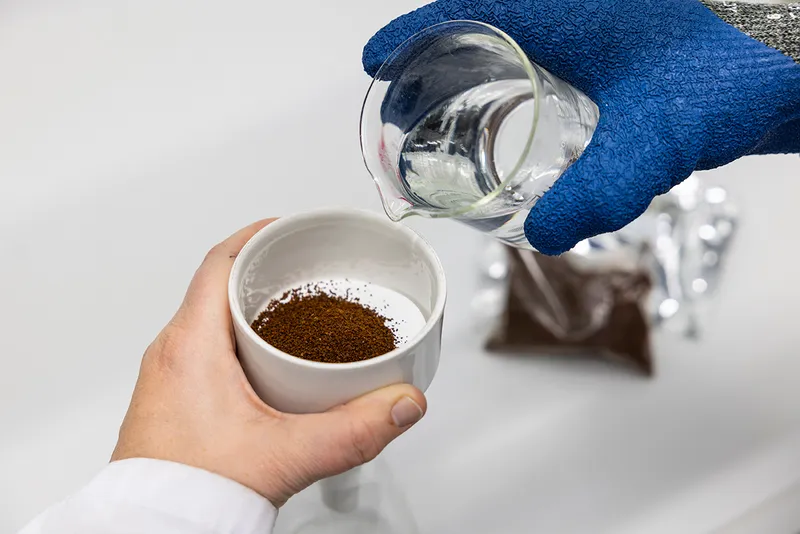Coffee is diverse. Strong and black, drowned in ice, or enough shots to see through time and space, we all have our preferences. But what about an entirely new type of coffee? Not a new type of roast, but coffee in a way we’ve never seen before – one made from the cells of plants.
It might sound bizarre, but it is a very real option and one that is gaining traction. Coffee’s immense popularity is strained, particularly due to its noticeable carbon footprint. Growing a single kilogram of Arabica coffee and exporting it to the UK produces greenhouse gas emissions equivalent to 15.33 kg of carbon dioxide on average.
The average cup of coffee requires 140 litres of water across the growing, processing and transporting stages, and reports suggest coffee production could half by 2050 due to climate change.
Despite these figures, the demand and interest in coffee are rising year on year. And this is where the cells come in.
What is cell-based coffee?
Cell-based coffee is made using samples of cells extracted from coffee plants. These cells are placed into a controlled environment called a bioreactor, where they are fed different nutrients and are allowed to multiply.
Once the cells have reached their desired quantity, they are then harvested from the bioreactor and dried out to remove any leftover moisture. What’s left at this stage is similar to a coffee bean.
Finally, this product can be roasted like traditional coffee, giving rise to the tastes, aromas and flavour profiles that we’ve come to expect from coffee.
How does it measure up to real coffee?
Currently, this is just the early stages, a first attempt at what could be the future of coffee. That means that there are still kinks to work out, and, more importantly, that there is still the potential to improve on the cell-based coffee model.

“Unlike the coffee that you find on supermarket shelves, this is by no means an optimised product, nor are any of the processes that are involved with it,” says Heikki Rischer, the head of plant biotechnology at VTT Technical Research Centre of Finland.
Rischer along with a team of researchers published a recent paper outlining a proof-of-concept for cell-based coffee, demonstrating its potential and showing an end result that could compete with a traditional cup of joe.
“We have brewed a cell-based coffee and had a sensory evaluation and chemical analysis. There are thousands of flavour molecules in a traditional coffee and we have achieved a big overlap with these,” says Rischer.
“It’s recognisable as coffee. The same colour and a similar taste, it is just missing some of the individual components to really get it there.”
Along with the taste, the other factor that this new coffee can’t quite match up to yet is caffeine quantity. However, with cell-based coffee being made in such a controlled environment, factors can be altered.
Flavour molecules or caffeine quantity could be fiddled with, aiming for the perfect end product.
Why cell-based coffee could be better for the environment
While cell-based coffee poses a unique challenge, Rischer thinks it could be worth the environmental rewards.
“The carbon footprint of coffee is massive. There’s the farming stages, the emissions to fly it across the world, shipment and all of these other factors. Because of all of this, prices of coffee are really volatile, it is going up,” says Rischer.
“We see concerns for the future because demand is rising pretty rapidly. Asia is now turning more to coffee, opening up a huge new market while resources are dwindling.”
While it sounds far more complicated, cell-based coffee is a much easier version to create. It doesn’t require the huge amount of water that normal coffee needs and it doesn’t rely on huge farms to grow it.
All of the production and agricultural production can be done locally which removes the need for worldwide transport, and complicated supply chains.
If the technology was perfected, cell-based coffee could taste the same as normal coffee, while costing less and having a smaller carbon footprint. But getting to that stage could be complicated.
“There is a long value chain with the coffee product. It involves many industries from the roasting, the farms, the technology that is used, manufacturing etc. To really advance this alternative coffee, you need to bring all of those companies and teams on board, this is the real challenge,” says Rischer.
Trying to turn an entire industry onto cell-based products isn’t easy – the same problem has been experienced by cell-based meats in the past. The most likely result is that we will see a small change.
As the technology improves, the offering of cell-based coffee could increase. While it will likely be expensive at first, and available in small batches, one day we could all be drinking coffee made in a lab.
Read more:
